1989 German Grand Prix race report
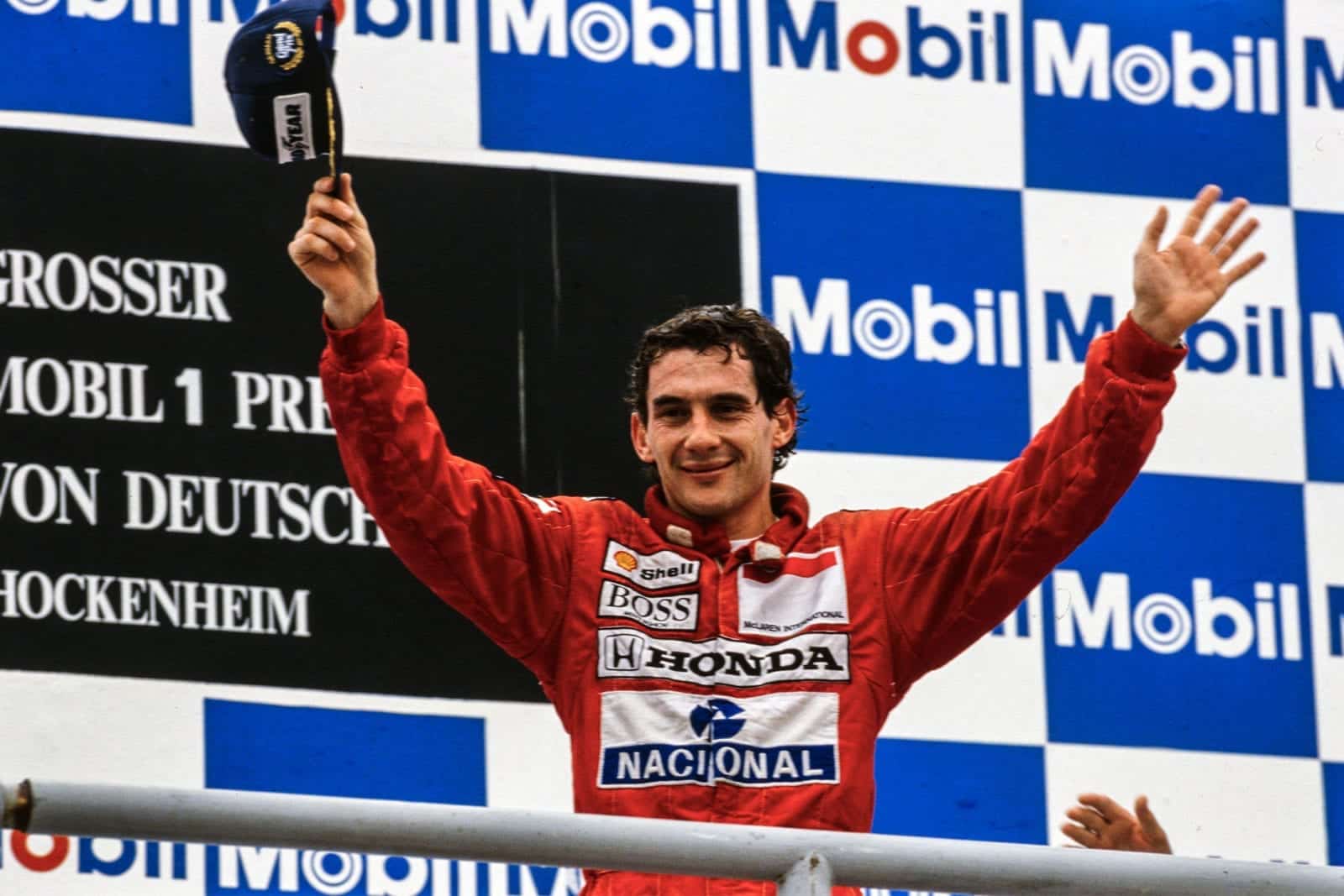
McLaren's Ayrton Senna took his fourth win of the season at the Hockenheimring
Motorsport Images
In the end, the result was all too familiar: Ayrton Senna first, Alain Prost second. Nothing too surprising about that, in this age of McLaren-Honda domination of Formula One.
Yet the German Grand Prix was much more of a race than the bare result suggests, and the action wasn’t confined to the battle for first place, either.
For once, though, it really was quite a fight. In fact, it was probably the most prolonged encounter between Senna and Prost since Ricard 1988, as the two ran within yards of one another for virtually the entire distance.
As expected, the MP4/5s and their Honda V10 engines were in a class of their own throughout the meeting. The stop-go nature of the Hockenheimring, whose already sparse character has been ruined further by chicanes, suited them down to the ground.
“The circuit could have been made for them,” said a wistful Nigel Mansell. “It’s one place during the year that really gives eve, advantage to McLaren and takes everything from us. We’re not far off on top-end power, but low down the Honda has a 40-50 bhp advantage. I’m not joking. I reckon it’s that bad.”
Indeed, if the never-say-die Briton exaggerates about anything these days, it’s not the deficit to Honda, but his estimate of the amount of power the Ferrari has up top. John Barnard, for example, reckons the V12 isn’t even a match for the V10 there despite his continuous pressure for prancing horses.
In qualifying, the front row story looked like having anything other than McLaren authorship, although the cynics took a rather long look at the claims that Senna’s really hot lap — not to mention his MP4/5’s monocoque — were ruined by a large rock which he ran over with two corners to go. It bounced beneath the chassis, and wrought more damage than the spin Senna had had on Friday morning, according to the story. In that untimed opening session, Ayrton had made a rare error entering the stadium, and spun for yards before whacking backwards into the Armco at a fair rate of knots.
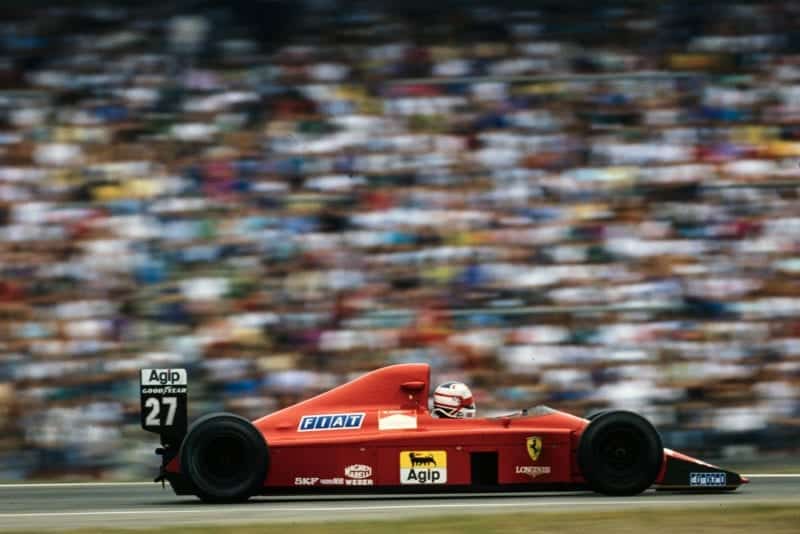
Ferrari’s Nigel Mansell was closet to the McLaren’s in qualifying
Motorsport Images
The impact bent the rail, but after fiddling with the gear-linkage within the cockpit for some time he was able to drive back to the pits and the McLaren lads eventually had the car running well enough for him to set his pole time that afternoon. And you wonder why McLaren is the top team? That sort of car strength and teamwork are two good reasons. In the afternoon Senna flew to record 1min 42.300sec, a full second clear of Prost at the time, and Alain wasn’t sandbagging. But was it really a rock that wrought the carbonfibre havoc? Or had Ayrton straightlined the chicanes for one blistering lap, and smashed the underside on the kerbs as a result? Nobody was saying, particularly since he was one office drivers warned that they would have their Saturday times disallowed if they continued to cut the chicanes. There were McLaren insiders who voiced the kerb-jumping thoughts as well, however …
Be that as it may, Senna would still have been on pole since his Saturday 1 min 42.790sec was faster than Feast’s improvement to 1 min 43.295sec, but at the start both were comprehensively upstaged as Gerhard Berger blasted through from the second row to lead for Ferrari.
Those who thought that the Imola conflagration might have daunted the Austrian have clearly had to reinvest in further thoughts; Hockenheim was another indication that he has, perhaps, gone the opposite way. “After surviving at Imola, be thinks he can walk on water,” said one Ferrari teamster. The truth of the matter is that Gerhard was giving his car everything, pounding over Orbs for lap after lap. Predictably, his lead hadn’t lasted to the first chicane before Senna slipped ahead, and before the end the lap Feast had followed through. Mansell, however, was being canny as he followed his team-mate.
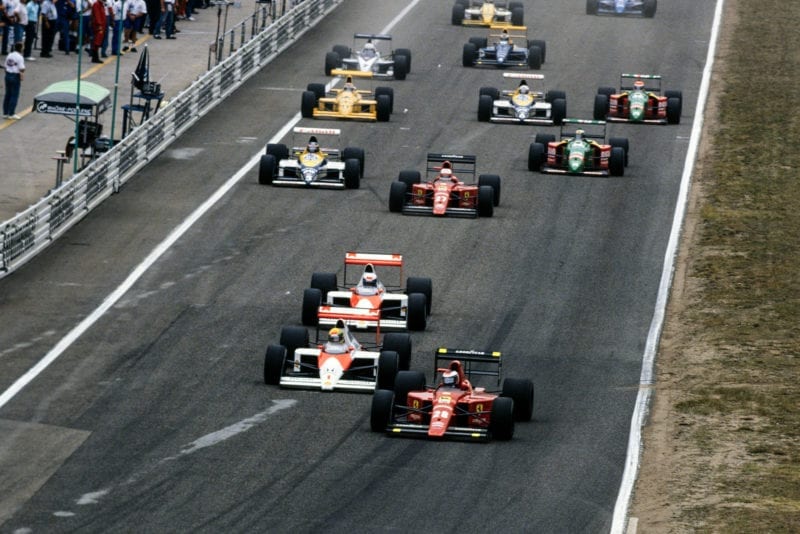
Gerhard Berger takes the lead in his Ferrari at the start
Motorsport Images
Tucked low down in the cockpit on his Friday qualifying run, Nigel had accidentally had a hard landing over a chicane kerb and damaged a vertebra. Though close to the kerbs in the race he was clearly saving his car grief, and could are that it was only a matter of time before the inevitable occurred with Gerhard’s. By the 14th lap the third-placed Ferrari’s left rear wheel’s rim was anything but circular after its maltreatment. Worse, it was leaking air from that Goodyear. As Gerhard approached the Ostkurve chicane the tor!tented rubber overheated and exploded, lust as Mansell’s own left rear had three Years earlier in Adelaide (albeit for different reasons). This time Nigel had a grandstand seat as No 28 launched itself over the entry kerb, nosedived enough to remove its cone and front wings, and then slithered into retirement on the right-hand side of the road. Gerhard walked away without a backward glance, once he’d briefly checked the front end, his Villeneuve spirit thwarted yet again.
Mansell, meanwhile, having narrowly avoided involvement in his team-mate’s antics, continued what he later described as a quiet race. Clearly outpaced, he himself was under no threat. In the circumstances, third place would do nicely, thanks. Mansell hadn’t given up; he was just being realistic. After all his retirements this year, another four points were welcome. Prost, however, was being aggressive, and it was good to see. Often a Senna lead is a prelude to a disappearing act, but not this time. Lap after lap Alain dogged Ayrton, and when the Frenchman dived in at the end of lap 17 for his scheduled tyre-stop the gap between them was less than a second. Front was delayed slightly — he claimed a clutch problem, Ron Dennis blamed him for not keeping his foot on the brakes — and was 32 sec adrift by lap 19 when Ayrton came in. However, a mechanic wasn’t quite sure the Brazilian’s right rear wheel had seated properly and insisted on checking it.
By the time both men were back to racing speed, Alain was nursing a near four-second lead. At first it stayed that way. Dammit, it even grew sober when the Frenchman had better fortune lapping Brundle’s overheating Brabham, but then as the race neared its conclusion Senna began to inch closer. By his imn admission Press was taking it as easy as he dared, trying not to take too much out of his car. He knew what effect aerodynamic turbulence has when you follow another car really closely, and thought he’d got it all figured out. Ayrton gobbled down to just over a second in arrears on lap 41 of the 45, but then Prost stabilised that. He felt he had the thing sewn up.
It made you think of some of Ayrton’s Formula Three drives back in 1983: how he and Martin Brundle had exited the Oulton Park race, for example. Would he and Front end up off the track, with Mansell laughing all the way to the rostrum?
The smart money was on a last-lap lunge in the stadium, but in a cruel anti-climax it proved unnecessary. As he exited the last chicane on lap 43, Alain struggled to engage sixth gear. Part of the transverse gearbox’s linkage had broken, and he had to finish without it. Senna flashed by. Prost limped home to six more points instead, possibly, of nine.
There was a final, unpleasant, twist for Ayrton. His close friend, mentor and business manager Armando Botelho Teixeira had been ill for some months with liver cancer, and had succumbed in Brazil the previous night. Only after one of the best races of his career, in which he had driven flat out all the way, was the news broken to him.
If Ferrari had offered McLaren its strongest challenge, then Benetton was the closest to Ferrari at Hockenheim, which was a source of great encouragement to a team in which the management is uncertainly split between Benetton’s new man Flavio Betastore and the whiphand cracked by Mike Kranefuss, head of Ford’s Special Vehicle Operations. After he’d kicked out Johnny Herbert, one might be forgiven for thinking Kranefuss was running the whole show, not just supplying engines, especially as Hockenheim was alive with rumour that he is trying to forge a link between John Barnard and Benetton for 1990. As the story had it, such a move would be part of the price of continuing to supply the new V8 on an exclusive basis.
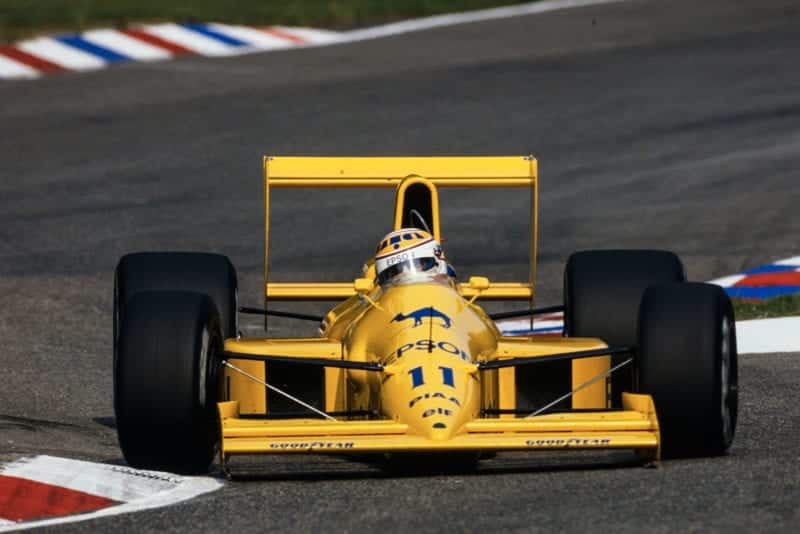
Veteran Nelson Piquet scored a fifth place for Lotus
Motorsport Images
On the one hand, Kranefuss expresses optimism for the new unit, one the other he talks of a possible V12. Germanic mercurialism apart, however, Geoff Goddard’s new motor looked pretty promising, and Sandro Nannini was the fastest man on the track when he lost fifth place to a faulty ignition sensor.
Herbert’s replacement Emanuele Pirro took up the reins, after a coming together with Thierry Boutsen had deposited the irate Belgian’s Williams Renault in the wall. The latter blamed the former, and vice versa, which probably meant it was one of those racing incidents.
Piero was doing very nicely, in fourth place, when he got out of shape entering the stadium on lap 27, rode up the kerb, and went head-on through several large polystyrene blocks. Although there were some moments of alarm as the medical car and then an ambulance were summoned, he was later walking around the paddock nursing nothing worse than cut and bruised legs. The Benetton performance was indication that Ford might well be right that a V8 can still hack it, even if aspirations to match Honda horsepower by the end of the year are guaranteed to keep the journalists amused. Certainly, it gave Williams Renault something else to ponder, as the Didcot cars were outclassed. In the end, Frank’s team had to be satisfied with Riccardo Patrese’s fourth place, its drivers twiddling their thumbs while impatiently awaiting the long verde FW13.
If the new Ford V8 looks promising, none of the other V8s do. Leastways, not as farm threatening the leading multi-cylindered engines h concerned. Right now, the Judd CV looks the best of the bunch, and in the Camel LOCUS at Hockenheim it proved it by taking Nelson Piquet into the points for the third time in four races.
.Like Benetton, Lotus had been in turmoil nit the removal of Fred Bushell as Executive Chairman following his legal problems, and Peter Warr as team director, as he wishes to “pursue other career opportunities”. In their place had come cuddly former REM design supremo Tony Rudd, father of the 1962 World Championship-winning machine and the complex H16, while Rupert Mainwaring now took full management responsibility.
The result was a more motivated team, the Brazilian’s fighting fifth (as much a product of the pre-Silverstone threat of suspension for the German GP), and a stirring battle from sixteenth to sixth by Satoru Nakaiima.
The latter did a workmanlike job that had one wondering just what Lotus’ test driver Martin Donnelly might have done in either of the cars, but a late dispute over track space with Derek Warwick deposited the Japanese driver into the weeds and left the Englishman to mop up the final point for Arrows.
Once again, the A11s had proved ill at ease on a really fast circuit, and neither the Brabhams nor the Marches looked settled, either. All ran in the midfield, Modena’s BT58 retiring with engine failure through overheating, and a food-poisoned Martin Brundle bringing his home eighth behind Andrea de Cesaris’ unspectacular Dallara. The latter’s team-mate Caffi retired early with a dead engine, and neither March made it home, Gugelmin losing sixth place when his CG891 stuck in fifth gear, Capelli being low down all weekend and retiring from an undistinguished 13th place with electronics problems.
If March has lost its way, Tyrrell also seems to have run out of steam. Jean Alesi again showed well to qualify tenth and run sixth before a long brake pedal tricked him into a brace of offs in the stadium, but poor old Jonathan Palmer had another nightmare weekend. Outqualified again by Alesi, he suffered fuel burns on his back after the tank nozzle leaked in the opening laps, then retired with yet another broken throttle cable. Maybe Jonathan just presses it too hard …
Minardi only got one car into the race, after Luis Sala was hopelessly off the pace in qualifying, as did Onyx, after Bertrand Gachot spoiled his domination of prequalifying by going off on Saturday afternoon. Pierluigi Martini proved he has a racer’s spirit by hounding Brundle to the flag, but Stefan Johansson was an early casualty with another rear wheel bearing failure.
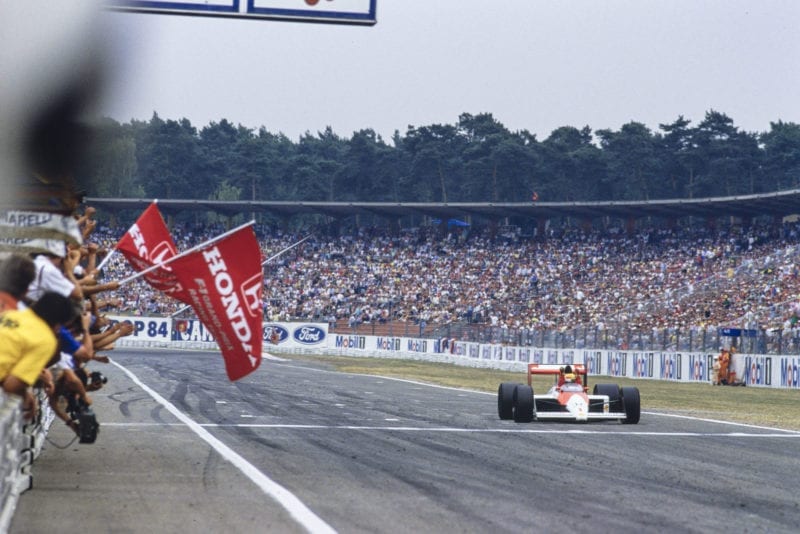
Senna crosses the line to take victory
Motorsport Images
The Larrousse Lolas didn’t exactly cover themselves in glory, either. Both just scraped through pre-qualifying — Alboreto beating former Larrousse pilot Yannick Dalmas by a mere thousandth of a second — but the Italian retired on his second lap with electrical failure, and after a startline nudge and spin onto the grass Philippe Alliot went out in a spectacular blaze after an oil pipe broke and sprayed lubricant over the car’s hot bits. If the German GP proved anything, McLaren Honda’s utter domination apart, it was that Alan Prost isn’t going to give Ayrton Senna any peace for the remainder of the year. If he does go to Ferrari, as is now expected, he is determined to take the number one with him. Nigel Mansell has openly expressed the opinion that Prost is the only driver in the pit-lane he can learn from, but quite what he would think of that, having just started a clothing line cooed his cherished No 27, remains to be seen.
